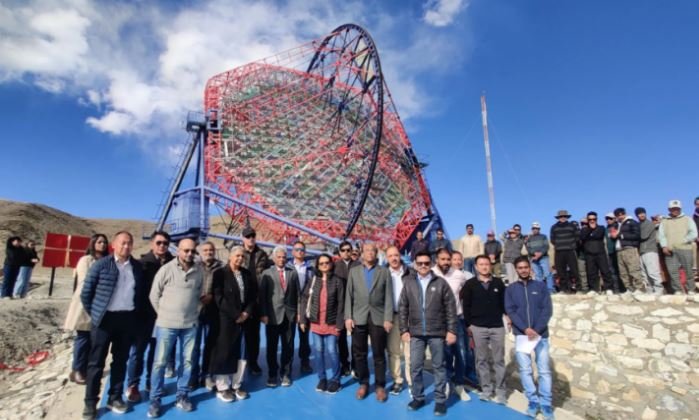Breakthrough in Astronomy: Hanle’s MACE Telescope to Unlock Secrets of the Universe’s Energetic Events
Asia's Largest Imaging Telescope Unveiled in Ladakh: A New Era for Cosmic Ray Research Begins
LADAKH, Oct 9: The inauguration of Asia’s largest imaging Cherenkov telescope, known as the Major Atmospheric Cherenkov Experiment (MACE), took place today at Hanle, a remote location in Ladakh, situated at an impressive altitude of approximately 4,300 meters. This observatory, recognized as the highest of its kind in the world, has been indigenously developed by the Bhabha Atomic Research Centre (BARC), based in Mumbai, in collaboration with the Electronics Corporation of India Ltd (ECIL) and various industry partners across India.
MACE is poised to position India at the forefront of global cosmic ray research, enabling scientists to study high-energy gamma rays. This capability will significantly enhance our understanding of the universe’s most energetic phenomena, including supernovae, black holes, and gamma-ray bursts. Even prior to its formal inauguration, the telescope has demonstrated its potential by successfully detecting gamma-ray flares from sources located as far as 200 million light-years away.
The specifications of MACE highlight its advanced engineering and design. With a diameter of 21 meters and a total weight of 175 tonnes, the telescope boasts a reflector area of 356 square meters, comprised of 1,424 diamond-turned metallic mirror facets. Its sophisticated structure includes 712 actuators and 1,088 photomultiplier tubes, distributed across 68 camera modules. This lightweight construction is designed for high strength and temperature endurance, ensuring optimal performance in the challenging conditions of its high-altitude environment.
The reflector surface, which spans over 350 square meters, features custom-built metallic mirror facets that possess exceptional reflective properties. These facets must be meticulously aligned with an accuracy of 2 millimeters over the parabolic surface to achieve the telescope’s intended performance. Additionally, the camera at the focal point incorporates specialized assemblies to enhance the efficiency of light collection, thus maximizing the telescope’s observational capabilities.
The selection of Hanle as the site for MACE is strategic, owing to its unique scientific advantages. The region experiences extremely low light pollution, which is crucial for gamma-ray observations. Furthermore, its geographical positioning allows MACE to observe cosmic sources that are not visible from other locations around the globe.
Dr. A.K. Mohanty, Chairman of the Atomic Energy Commission and India’s nuclear chief, remarked, “Hanle is like heaven for gamma-ray astronomers, offering dark skies, low humidity, and almost no air pollution.” He expressed optimism about the future of gamma-ray astronomy at Hanle, suggesting that additional gamma-ray telescopes could be established, thus transforming the area into a premier destination for international astronomers seeking collaboration.
With the operational capabilities of MACE, scientists now have a powerful tool at their disposal to delve deeper into the mysteries of the universe, enhancing our comprehension of high-energy gamma rays and their implications for astrophysics.




